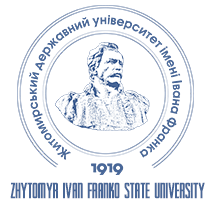MODEL OF DIGITAL COMPETENCE FORMATION IN EDUCATIONAL INSTITUTION MANAGERS USING COMPUTER TECHNOLOGIES
DOI:
https://doi.org/10.35433/pedagogy.2(121).2025.17Keywords:
digitalization, digital competence, management, manager of an educational institution, computer technologies, model, modeling, principles of competence formation, structural components of the modelAbstract
The article considers the process of developing the digital competence of managers in educational institutions as a systemic object, encompassing fundamental and mandatory categories: purpose, content, forms, methods, means, and results. The proposed model for the formation of digital competence in managers of educational institutions using computer technologies assumes that a modern manager of an educational institution must have innovative methods and technologies for the effective implementation of distance, blended, asynchronous and synchronous, cloud learning, flipped and virtual classrooms, e-learning platforms, gamification, digital storytelling, organization of the educational process management system, etc. The purpose of the model is to assess the effectiveness of the formed digital competence of managers of educational institutions. To achieve this goal, the functioning of the entire set of components (among which we distinguish structural ones) is required, which is ensured by adherence to the relevant fundamental principles of organization and organizational work with managers of educational institutions to form digital competence.
The article investigates the peculiarities of building a model for the formation of digital competence in managers of educational institutions by means of computer technologies, which is based on pedagogical principles, namely, humanistic orientation, dialogical nature of pedagogical interaction, integrity in the choice of educational material, the connection of educational theory with practice, and structural components: motivational and target, organizational and content, operational and activity, control and result. The model for the formation of digital competence in managers of educational institutions using computer technologies is based on a systematic approach that ensures the integrity and interconnection of each of its constituent elements, and an integrated approach to the development of digital competence ensures an increase in the efficiency of management in education and creates conditions for the innovative development of an educational institution.
References
Bondar, V.I. (2000). Teoriia i tekhnolohiia upravlinnia protsesom navchannia v shkoli [Theory and technology of managing the educational process in school]. Kyiv: FADA LTD, 191 [in Ukrainian].
Bielova, N.P. (2021). Suchasni informatsiini tekhnolohii v upravlinni osvitoiu [Modern information technologies in education management]. Kharkiv: KhNPU, 210 [in Ukrainian].
Bieliakov, K.I. (2008). Informatyzatsiia v Ukraini: problemy orhanizatsiinoho, pravovoho ta naukovoho zabezpechennia [Informatization in Ukraine: problems of organizational, legal, and scientific support]. Kyiv: KVITS, 576 [in Ukrainian].
Busel, V.T. (ed.). (2009). Velykyi tlumachnyi slovnyk suchasnoi ukrainskoi movy [Comprehensive explanatory dictionary of modern Ukrainian language]. Kyiv–Irpin: VTF "Perun", 1736 [in Ukrainian].
Virvan, L.A. (2001). Sut, struktura i zavdannia analityky u zabezpechenni efektyvnosti upravlinskykh rishen [Essence, structure, and tasks of analytics in ensuring the effectiveness of management decisions]. Extended abstract of Doctor’s thesis. Kyiv: Kyiv National Economic University, 19 [in Ukrainian].
Volkova, N.P. (2005). Profesiino-pedahohichna komunikatsiia: teoriia, tekhnolohiia, praktyka [Professional and pedagogical communication: theory, technology, practice]. Dnipropetrovsk: DNU Publ., 304 [in Ukrainian].
Vprovadzhennia innovatsiinykh tekhnolohii upravlinnia osvitnim zakladom v systemu osvity [Implementation of innovative management technologies in the education system]. Retrieved from: https://vseosvita.ua/library/embed/002hvg-9077.docx.html [in Ukrainian].
Zakharchenko, T.O. (2020). Tsyfrovi kompetentnosti pedahohichnykh pratsivnykiv yak umova yakisnoi osvity [Digital competences of teaching staff as a condition for quality education]. Visnyk Osvity Ukrainy – Bulletin of Education of Ukraine, 5, 33-40 [in Ukrainian].
Informatsiia yak holovnyi predmet pratsi kerivnyka navchalnoho zakladu [Information as the main subject of the work of the head of an educational institution]. Osvita.ua. Retrieved from: https://urok.osvita.ua/materials/administration/36407/ [in Ukrainian].
Kondratenko, I.V. (2021). Tsyfrova kompetentnist kerivnyka navchalnoho zakladu: vyklyky i perspektyvy [Digital competence of an educational institution leader: challenges and prospects]. Pedahohichnyi Chasopys – Pedagogical magazine, 2, 45-52 [in Ukrainian].
Kontseptsiia rozvytku tsyfrovykh kompetentnostei v Ukraini [Concept of digital competence development in Ukraine]. Ministry of Education and Science of Ukraine. (2020). Retrieved from: https://mon.gov.ua/ua [in Ukrainian].
Pavliutenkov, Ye.M. (2008). Modeliuvannia v systemi osvity (u skhemakh i tablytsiakh) [Modeling in the education system (in diagrams and tables)]. Kharkiv: Vydavnycha hrupa "Osnova", 128 [in Ukrainian].
Petrenko, O.M. (2022). Upravlinnia osvitnim zakladom u tsyfrovu epokhu [Managing an educational institution in the digital age]. Kyiv: Osvita, 180 [in Ukrainian].
Spirin, O. (2013). Kryterii i pokaznyky yakosti informatsiino-komunikatsiinykh tekhnolohii [Criteria and indicators of the quality of information and communication technologies]. ITZN NAPN Ukrainy, t. 33, is. 1 [in Ukrainian].
Filosofskyi entsyklopedychnyi slovnyk [Philosophical encyclopedic dictionary]. (2002). Kyiv: Abris, 751 [in Ukrainian].
Downloads
Published
Issue
Section
License

This work is licensed under a Creative Commons Attribution-NonCommercial-NoDerivatives 4.0 International License.
Authors published in this journal agree to the following terms:
a) The authors reserve the right to author their work and grant the journal the right to first publish this work under the Creative Commons Attribution License, which allows others to freely distribute the published work with a mandatory link to the authors of the original work and the first publication of the work therein magazine.
b) Authors have the right to enter into separate additional agreements regarding the non-exclusive distribution of the work in the form in which it was published by this journal (for example, posting work in an electronic repository of the institution or publishing as part of a monograph), provided that the reference to the first publication of the work is maintained therein. magazine.
c) Journal policy permits and encourages the submission of manuscripts by the authors on the Internet (for example, in repositories of institutions or on personal websites), both prior to submitting this manuscript to the editorial board and as it contributes to the emergence of productive scientific discussion, and has a positive impact on the promptness and dynamics of citing a published work (see The Effect of Open Access).

 ISSN
ISSN 





